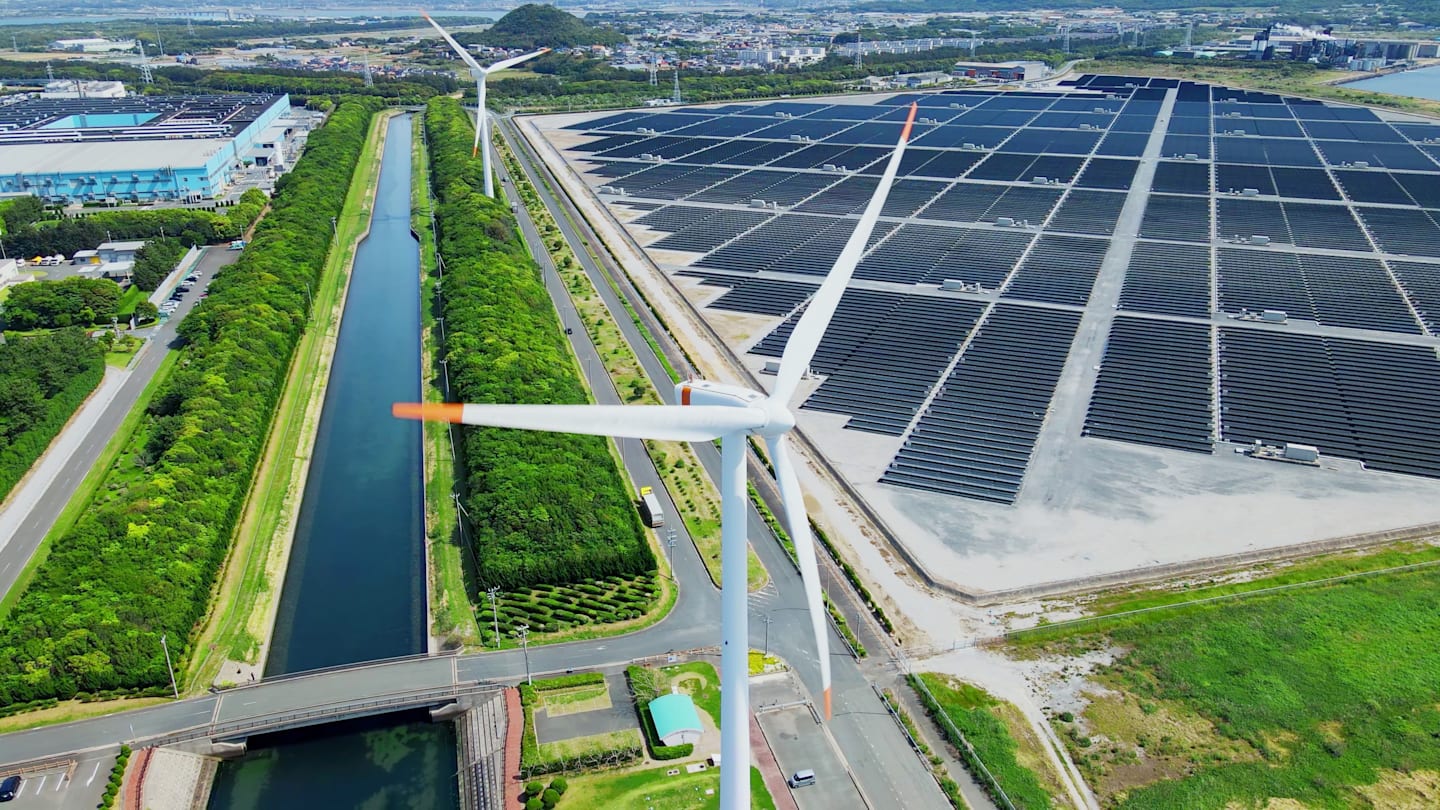ESG Panel on Decarbonization Risks and Opportunities
Hosted by American Century

Governments, businesses, and consumers are shifting to clean, renewable energy to help the world decarbonize. On November 3, American Century hosted a panel discussion, moderated by our Head of Sustainable Investing Sarah Bratton Hughes, on the implications of the decarbonization effort for investors.
Complementing Sarah’s deep knowledge of sustainability issues across the asset management industry, the panelists represented three other experienced points of view. The combination resulted in a refreshingly balanced discussion—no rants or heated arguments, just an interesting mix of perspectives.
Here are some highlights of the event—we invite you to view and share the panel discussion here.
Climate Change – Physical Risks and Decarbonization Opportunities
Sarah kicked off the discussion by observing that climate change is already affecting both economic conditions and government policies. She noted that as the cost of the physical risks of climate change rises, it can prompt innovation and may represent opportunities for investors as companies seek new ways to decarbonize. Sarah asked the panelists to comment on those opportunities.
Keesa Schreane, consultant, speaker, and author of the book “Gambling on Green: Uncovering the Balance among Revenues, Reputations, and ESG” emphasized that the physical risks of climate change have implications for individual investors, and that the investment horizon is important when looking to invest in decarbonization. In pursuing these opportunities, companies must engage with stakeholders, such as employing people in the community where they are building new capabilities, not just swooping in and “taking over.”
Pedro Matos, Academic Director, Darden School of Business, University of Virginia recently published research that explores the best way to decarbonize an investor’s portfolio. He noted that much of what must be done to decarbonize will happen outside of public markets, given that less than 40 percent of Scope 1 emissions are represented by public companies. His research considers the question, “what can investors do to invest in and capture potential alpha from these opportunities?”
Pedro noted that many investors who want to decarbonize their portfolios are allocating capital toward best-in-class “green” companies and de-emphasizing (tilting away from) “brown” companies. However, when one investor sells shares in a company, someone else buys them; therefore, he questions whether divesting really helps to decarbonize the planet because the capital that supports “dirty” energy is not leaving the system. Another approach is considering high carbon-emitting companies and engage with them to encourage decarbonizing.
Engagement versus Divestiture
Pursuing the issue of engagement, Brian Matt, CFA, Director - Head of ESG Advisory, New York Stock Exchange, pointed out that most companies do expect engagement from their investors and are looking for ways to decarbonize. For example, “many companies are seeking to reduce distances among suppliers in their supply chains as the entire procurement function becomes much more important than it ever was before.” He said that investors who are focused on stewardship naturally tend to have a long-term perspective, and that boards are hearing about and becoming better educated on ESG issues.
Sarah confirmed this, saying that companies are proactively reaching out to American Century to ask about our expectations as part of their off-season engagement activities. “We are starting to see that even though in the current economic climate there may be more immediate, more pressing concerns, companies are seeing benefits of commitments they made to decarbonizing some years ago.”
On the other hand, Pedro raised the issue of the lack of transparency in private markets. When companies are taken private, or were never publicly held, there is less transparency and really no engagement. That can conceal a lack of action. Although public companies can push problems upstream or downstream through their supply chains, there is a link between transparency and public markets where shareholders can engage with corporations on decarbonizing.
Keesa agreed, noting that in doing research for her book she investigated the implications of divesting. She concluded is that it does not “punish” the company but does limit asset managers’ ability to engage with management. She said that many investors are focusing more on engagement as the way to push for their long-term goals.
Sarah noted that American Century recently sponsored a survey of institutional asset owners in the Nordic countries and the Netherlands, who are global leaders in sustainable investing. By definition, they invest with a very long-term perspective that decarbonizing will require. The survey shows a shift away from the Best-in-Class approach toward a focus on Best-in-Progress, which ties into what American Century calls an “alpha-plus” goal—traditional financial alpha plus environmental and social alpha. That's really what that a Best-in-Progress approach is targeting, because it focuses on change going forward, not what has been done to-date.
Decarbonization Risks
Brian observed that the ability to assign a price to emitting carbon means we can disclose that cost and use that information in financial decision-making. That’s a big deal and can help incentivize companies to reduce costs by decarbonizing. Utilities are looking to bring on as much renewable energy as possible and to use green financing to do so. For Industrials, new rules stating that every ship will be rated on its carbon footprint improves the ability to measure the actual cost of carbon across a supply chain. That will likely affect pricing, especially given a new program in Europe that may involve a cross-border carbon tax.
Pedro commented that it is interesting to measure not only the risk to a company’s balance sheet due to the ability to price carbon, but also the value of the intellectual property arising from this space, from EVs to carbon capture technologies, and more. He suspects a relatively small percentage of this IP is currently generating revenue and thinks we are in the early stages of seeing investment opportunities.
Expanding on this, Sarah explained that her team is doing work on “Scope 4 Emissions” which she defines as how a company is working to take carbon out of the atmosphere. She noted that this gets back to the “divest or engage” issue because we will need traditional industries to manufacture these new technologies.
Sarah also noted that while many recognize the value in sustainable investing, we need to understand and show clear benefits to ESG skeptics. That, in turn, gets at the issue of a Just Transition – making sure that moving to cleaner energy does not leave workers in the fossil fuel industry behind. Perhaps ironically, Texas is one of the largest producers of wind energy in the U.S., with a worker population that has experience on offshore oil rigs and are best positioned to work on offshore wind farms.
In her words, the U.S. can’t decarbonize without Texas, and the world can’t decarbonize without the U.S. But we can’t take the express elevator to a decarbonized world; we need to take an escalator.
Final Thoughts: Fast-forward Five Years?
Sarah asked the panelists to predict what investing sustainably will be focused on five years from now, particularly with respect to the move to clean energy.
Keesa – We will expand our view of what “outperformance” means to include how we engage with and involve our workforce and suppliers, and even our customers to make sure we reflect their values.
Pedro – The relationship between energy independence and a shift to clean energy is clear. My students unequivocally see that we must get to a decarbonized world, but I also see us as being in echo chambers and we need to do a better job of understanding other points of view.
Brian – Given public companies’ obligations to maintain a listing on an exchange, regulation is one part of transparency, but we need more voluntary participation. This will happen as disclosures become more standardized.
Sarah summarized by observing, “in the short-term I’m hearing more engagement, more transparency in carbon pricing, and more innovation. There will be significant short-term pain because of high energy costs, particularly in Europe, but ironically this will accelerate the shift to renewables.” Five years from now, she said, I hope there is no such thing as “sustainable investing” – I hope it’s all just “investing”.
Many of American Century’s investment strategies incorporate sustainability factors, using environmental, social, and/or governance (ESG) data, into their investment processes in addition to traditional financial analysis. However, when doing so, the portfolio managers may not consider sustainability-related factors with respect to every investment decision and, even when such factors are considered, they may conclude that other attributes of an investment outweigh sustainability factors when making decisions for the portfolio. The incorporation of sustainability factors may limit the investment opportunities available to a portfolio, and the portfolio may or may not outperform those investment strategies that do not incorporate sustainability factors. ESG data used by the portfolio managers often lacks standardization, consistency, and transparency, and for certain companies such data may not be available, complete, or accurate.
The opinions expressed are those of American Century Investments (or the portfolio manager) and are no guarantee of the future performance of any American Century Investments' portfolio. This material has been prepared for educational purposes only. It is not intended to provide, and should not be relied upon for, investment, accounting, legal or tax advice.
This material has been prepared for educational purposes only. It is not intended to provide, and should not be relied upon for, investment, accounting, legal or tax advice.
Investment return and principal value of security investments will fluctuate. The value at the time of redemption may be more or less than the original cost. Past performance is no guarantee of future results.





